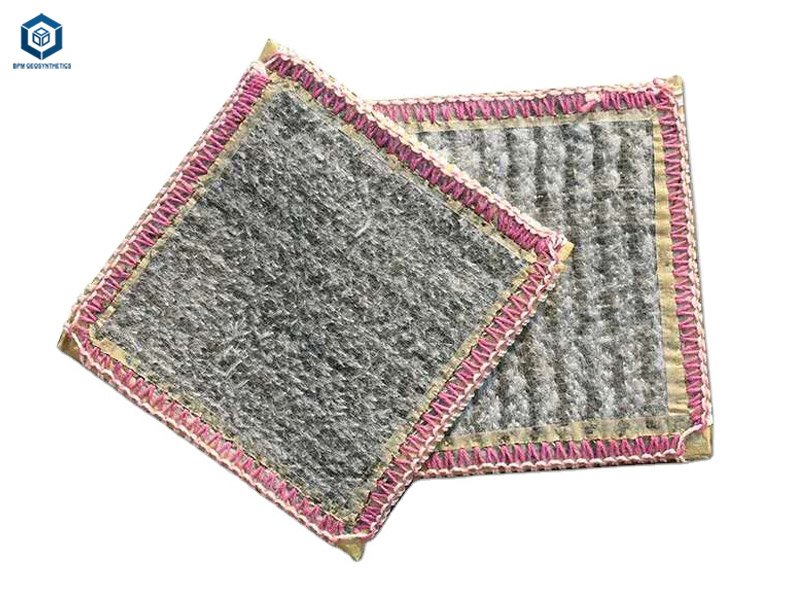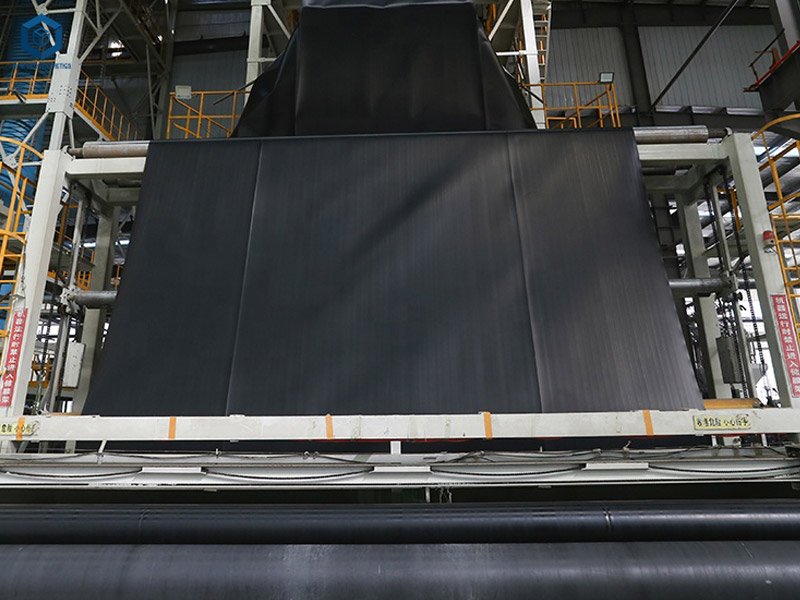Geosynthetic clay liner and geomembrane are geosynthetic materials used in a variety of engineering and environmental applications. Although they have some similar anti-seepage properties. But they have obvious differences in composition, performance and application.
BPM Geosynthetics is the leading geosynthetic clay liner and geomembrane manufacturer and supplier with 13+ years of Geosynthetic clay liner and HDPE geomembrane manufacturing experinces. In this article, we will discuss the differences of geosynthetic clay liners vs geomembranes. By comparing the differences between the two, we can make a better choice between a geosynthetic clay liner (GCL) and a geomembrane for your specific project.
1.What is the Geosynthetic Clay Liner?
Geosynthetic clay liner (GCL), also known as clay blanket, bentonite blankets, bentonite mats, prefabricated bentonite clay blankets and clay geosynthetic barriers, are factory-made hydraulic barriers consisting of a layer of bentonite or other composed of a very low permeability material supported by geotextiles and/or geomembranes that are mechanically fastened together by needling, stitching, or chemical adhesives. GCL liner is widely used in landfills to trap internal leakage. Its bentonite, consisting primarily (>70%) of montmorillonite or other expanded clays, is the preferred and most commonly used GCL. A typical GCL structure consists of two layers of geosynthetic material sewn together and surrounded by a layer of natural or processed Sodium bentonite. Typically, woven and/or nonwoven textile geosynthetics are used, however, polyethylene or geomembrane layers or geogrid geotextile materials have also been incorporated into the design or replaced the textile layer for added strength.
BPM geosynthetic clay liners are geosynthetic material specially used to prevent leakage in artificial lakes and waterscapes, landfills, underground garages, rooftop gardens, pools, oil depots and chemical storage yards. It is made of high-expansion Stable sodium bentonite is filled between a special composite geotextile and a non-woven fabric. The bentonite anti-seepage mat made by acupuncture can form many small fiber spaces. However, the bentonite particles cannot flow in one direction and will flow in one direction when exposed to water. A uniform and high-density gel-like waterproof layer is formed inside the pad to effectively prevent water leakage.
1.1 Geosynthetic Clay Liner Features
- High density and strong self-retaining water performance;
- Permanent waterproof performance;
- Easy construction, short construction period, and does not require special inspection after construction. If waterproofing defects are found, it is easy to repair. GCL The waterproof blanket has the shortest construction period among existing waterproof materials;
- It is not affected by temperature and will not break brittle in cold climate conditions;
- Green and environmentally friendly, bentonite is a natural inorganic material, harmless to the human body and non-toxic to the environment. Special impact and good environmental protection.
2.What is A Geomembrane?
A geomembrane is an extremely low-permeability synthetic membrane liner or barrier that can be used with any geotechnical-related material to control fluid (liquid or gas) migration in man-made projects, structures or systems. Geomembranes are made from relatively thin, continuous polymer sheets, but they can also be made by impregnating geotextiles with asphalt, elastomers or polymer sprays, or as multi-layer asphalt geocomposites. Continuous polymer sheet geomembranes are by far the most common.
BPM Geosynthetics geomembrane is a waterproof barrier material produced from high-density polyethylene resin. The full name is “high-density polyethylene film”, which has excellent environmental stress cracking resistance, low temperature resistance, aging resistance, corrosion resistance, a large operating temperature range (-60–+60) and a long service life. It is widely used in domestic waste landfill anti-seepage, solid waste landfill anti-seepage, sewage treatment plant anti-seepage, artificial lake anti-seepage, tailings treatment and other anti-seepage projects.


3 What is the Difference of Geosynthetic Clay Liner VS Geomembrane?
3.1 Different Composition of f Geosynthetic Clay Liner VS Geomembrane
Geosynthetic Clay Liner consists of a layer of bentonite encapsulated between two geotextiles or geocomposites. Bentonite is a natural clay with excellent swelling properties that provides high levels of water conductivity and chemical resistance.
Geomembranes are synthetic materials made from flexible polymer sheets. They are typically made from materials such as high-density polyethylene (HDPE), low-density polyethylene (LDPE), polypropylene (PP) or polyvinyl chloride (PVC). BPM Geosynthetics geomembranes offer excellent impermeability and chemical resistance.
3.2 Different Functions of Geosynthetic Clay Liner VS Geomembrane
3.2.1 Main Functions of Geosynthetic Clay Liner (GCL)
GCL waterproof blanket, Sodium Bentonite Geosynthetic Clay Line, is a new type of waterproof material. It is made of natural sodium bentonite, wrapped with two layers of geotextile, and reinforced with needle punching. Its anti-leakage mechanism is: the sodium-based particle bentonite selected for the bentonite waterproof blanket can expand more than 24 times when exposed to water, forming a uniform colloid system with high viscosity and low filter loss. Under the restriction of two layers of geotextile , causing the bentonite to expand from disorder to order. The result of continuous water absorption and expansion is to make the bentonite layer itself dense, thus having a waterproof effect. In order to facilitate construction and transportation, bentonite is locked between two layers of geosynthetic materials to protect and reinforce, giving the GCL waterproof blanket a certain overall tensile and puncture strength. GCL is primarily used as a barrier to prevent fluid migration in applications such as landfill covers, safety basins, and other hydraulic barriers. The bentonite in GCL swells on contact with water, creating a low-permeability barrier.
3.2.2 Main Geomembrane Functions
HDPE Geomembrane uses the impermeability of plastic films to block leakage channels in earth dams. It uses its large tensile strength and elongation to withstand water pressure and adapt to dam deformation. It aims to provide a highly impermeable barrier to prevent fluids ( including liquids and gases) migration. They are commonly used in applications such as landfill liners, ponds, reservoirs, mining facilities and other containment systems.
3.3 Permeability Properties
Geosynthetic Clay Liner (GCL) GCLs exhibit relatively low permeability due to the swelling properties of bentonite clay. The bentonite clay particles create a tortuous path for fluid flow, reducing hydraulic conductivity.
HDPE Geomembranes have very low permeability, providing an excellent barrier against fluid migration. They are engineered to have consistent and predictable permeability characteristics.
3.4 Installation Processes
3.4.1 Geosynthetic Clay Liner (GCL) Installation Process
Geosynthetic clay liner is typically installed by unrolling them onto the prepared subgrade. The seams between adjacent GCL panels are often overlapped and mechanically or chemically bonded.
3.4.2 Geomembrane Installation Process
Geomembranes are installed by unrolling the sheets over the prepared subgrade and then seaming them together using various techniques such as heat welding, adhesive bonding, or fusion.


3.5 Strength and Durability
Geosynthetic Clay Liner (GCL) provide some tensile strength and puncture resistance due to the geotextile or geocomposite layers. However, they are generally less mechanically robust compared to geomembranes.
HDPE Geomembranes offer high tensile strength, tear resistance, and puncture resistance, making them more durable and suitable for applications that require greater mechanical performance.
4 Summary
In short, geosynthetic clay liner (GCL) relies on the swelling properties of bentonite to provide a low-permeability barrier, while the main mechanism of geomembrane is to use the impermeability of plastic films to block earth dam leakage channels, with its greater tensile strength and elongation to withstand water pressure and adapt to dam body deformation; GCL is commonly used for hydraulic barriers, while geomembranes are used as general purpose liners and barriers in a variety of geotechnical and environmental applications. In some projects with high anti-seepage requirements, the two will be used together to improve the anti-seepage effect of the project.
If you have any questions about geosynthetic clay liner and geomembrane, please contact us at any time.
Thanks for reading.





